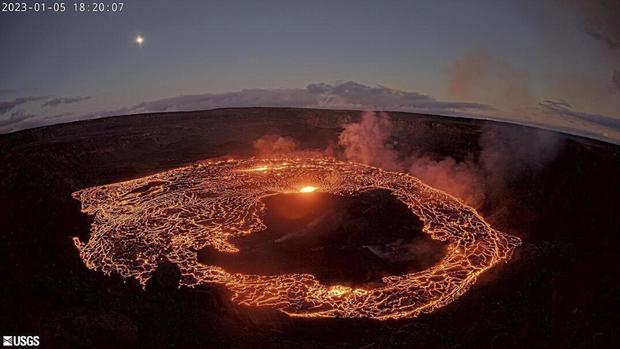Hawaii's Kilauea volcano is erupting once again
Weeks after Hawaii's Mauna Loa erupted for the first time in decades, neighboring volcano Kilauea is showing activity again after a brief pause, according to officials.
Kilauea -- which had stopped erupting last month for the first time since September 2021 amid Mauna Loa's own lava eruption and subsequent slowdown -- had increased earthquake activity beneath its summit and recorded ground deformation on Thursday morning, officials said.
"Kilauea volcano is erupting," the Hawaiian Volcano Observatory and the US Geological Survey said on Thursday. A glow was detected in nearby webcam images, "indicating that the eruption has resumed within Halemaʻumaʻu crater in Kilauea's summit caldera" at Hawaii Volcanoes National Park, the agencies said.
Officials elevated Kilauea's volcano alert level to "warning" status as well as updated its aviation color code from orange to red on Thursday before dropping the levels down again on Friday.
Hawaiian Volcano Observatory "is lowering Kīlauea's volcano alert level from WARNING to WATCH because the initial high effusion rates are declining, and no infrastructure is threatened," the Friday update says.
The color code was changed back to orange for aviation on Friday "because there is currently no threat of significant volcanic ash emission into the atmosphere outside of the hazardous closed area within Hawai'i Volcanoes National Park," according to the update.
Because the eruptions is occurring within a closed portion of the national park, "high levels of volcanic gas are the primary hazard of concern, as this hazard can have far-reaching effects down-wind," according to a status report from the Hawaiian Volcano Observatory.
It also warns residents to avoid exposure to volcanic particles that could waft some distance from the eruption.
The National Park Service has posted an air quality alert on its website, warning that unhealthy levels of volcanic pollutants can occur. It includes charts with regular air quality readings, particularly relevant for those with pre-existing respiratory conditions. Mostly "good" air quality readings had been recorded through Friday morning.
Visitors to the national park may encounter a "minor hazard," the status report says.
"Visitors to Hawaiʻi Volcanoes National Park should note that under southerly (non-trade) wind conditions, there is potential for a dusting of powdery to gritty ash composed of volcanic glass and rock fragments."
The eruption is currently confined to the crater and poses "no threat to communities," the Hawaii Emergency Management Agency said on social media.
Kilauea's eruption in 2018 was one of the most destructive in recent Hawaii history, forcing evacuations of surrounding neighborhoods and destroying hundreds of homes.
